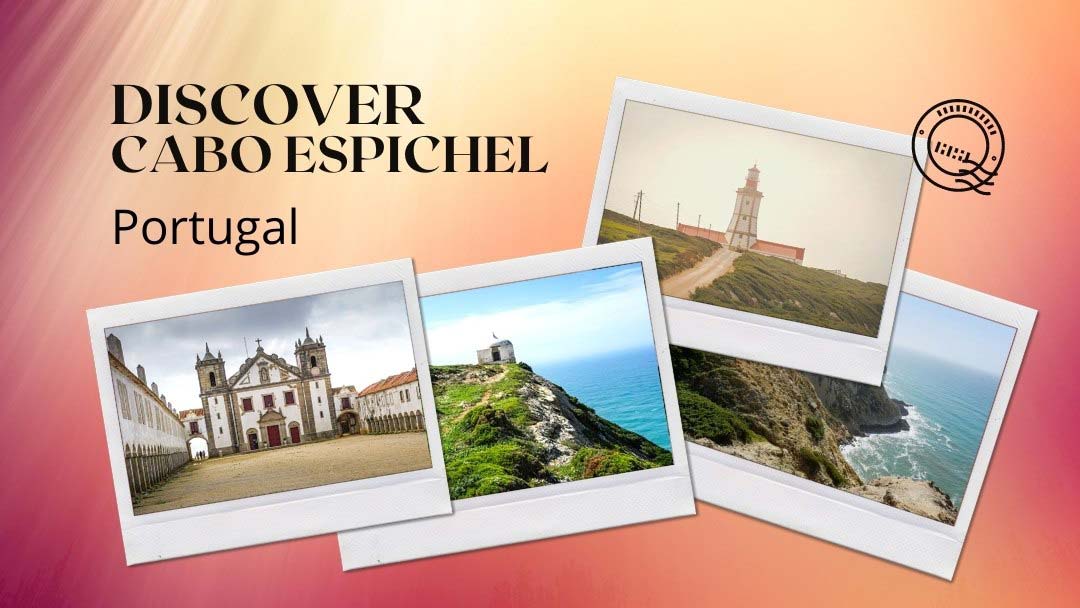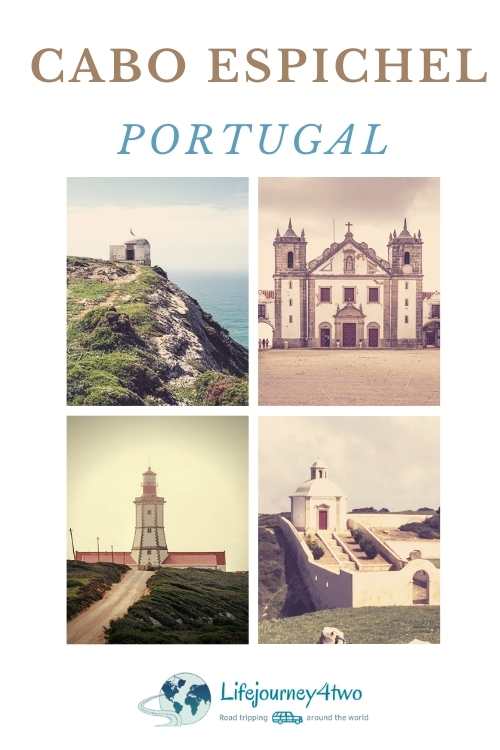Cabo Espichel, in southwest Portugal, is located at the tip of the wind-swept Setubal Peninsula. It is renowned for its rugged cliffs and powerful seas and as an important pilgrimage destination.
This historic site has drawn people from far and wide for centuries.
As our visit to Sesismbra ended, the allure of Cabo Espichel beckoned us. It was irresistible to add this unique destination to our campervanning in Portugal adventure.
Whether you’re a nature lover, history buff, or spiritual seeker, Cabo Espichel’s wild beauty and fascinating history await.
Explore the captivating legends, historical landmarks, and ancient dinosaur tracks that make this destination truly unique.

🥾 Cabo Espichel – Quick Summary
- Location: It is situated on the Setubal Peninsula in the southwest of Portugal amongst a landscape of rugged cliffs, pounding surf and gusting winds.
- Reason to Visit: Cabo Espichel offers dramatic scenery and scenic hikes for nature lovers, a centuries-old pilgrimage church for those who enjoy history and even dinosaur footprints that all the family will have fun searching for.
- Best Time to Visit: Although sunny, summer days are long and hot, so consider visiting in late spring or early autumn to avoid the heat and the holiday crowds.
- What to Bring: Essential items include water, sunscreen, a hat, sturdy hiking shoes, and possibly a light snack. Don’t forget your camera to capture the views and extra clothing layers to combat the chill factor from the late afternoon winds.
- Length of Stay: A half-day visit would tick most of the must-see boxes; however, a full day would allow you to see all Cabo Espichel offers.
- Food and Drink: A cafeteria is on site and is a cash-only establishment.
- Parking: Cars and motorhomes can park for free in the large open area by the church, central to the other sights.
Map: Cabo Espichel and Attractions
Discovering Cabo Espichel
Nestled at the southern tip of the Setubal Peninsula, Cabo Espichel offers a captivating mix of natural beauty, historical intrigue, and spiritual significance.
Here’s what makes this wild and windswept cape a must-visit destination.
Location:
Cabo Espichel is situated at the tip of the Setubal Peninsula in southwest Portugal, approximately 15 km from Sesimbra and 40 km south of Lisbon.
Known for its dramatic landscapes, the cape features towering cliffs, powerful seas, and sweeping winds that define its wild beauty.
Historical Significance:
For centuries, Cabo Espichel has been an important pilgrimage site. The Sanctuary of Our Lady of Cape Espichel (Nossa Senhora do Cabo Espichel) has drawn worshippers with its storied past and religious significance.
The area is steeped in legend, including the miraculous appearance of the Virgin Mary riding a giant mule in the 15th century, leaving a trail of hoofmarks that are, in fact, dinosaur footprints.
Another version is that two elderly persons were given signs from Heaven in their dreams. They followed this calling to the place where they saw the image of Our Lady of the Cape.
The temple, Nossa Senhora do Cabo Espichel, was built as a place of worship, and nearby, the Ermida da Memória or Hermitage of Memory, marks the exact spot of the apparition.
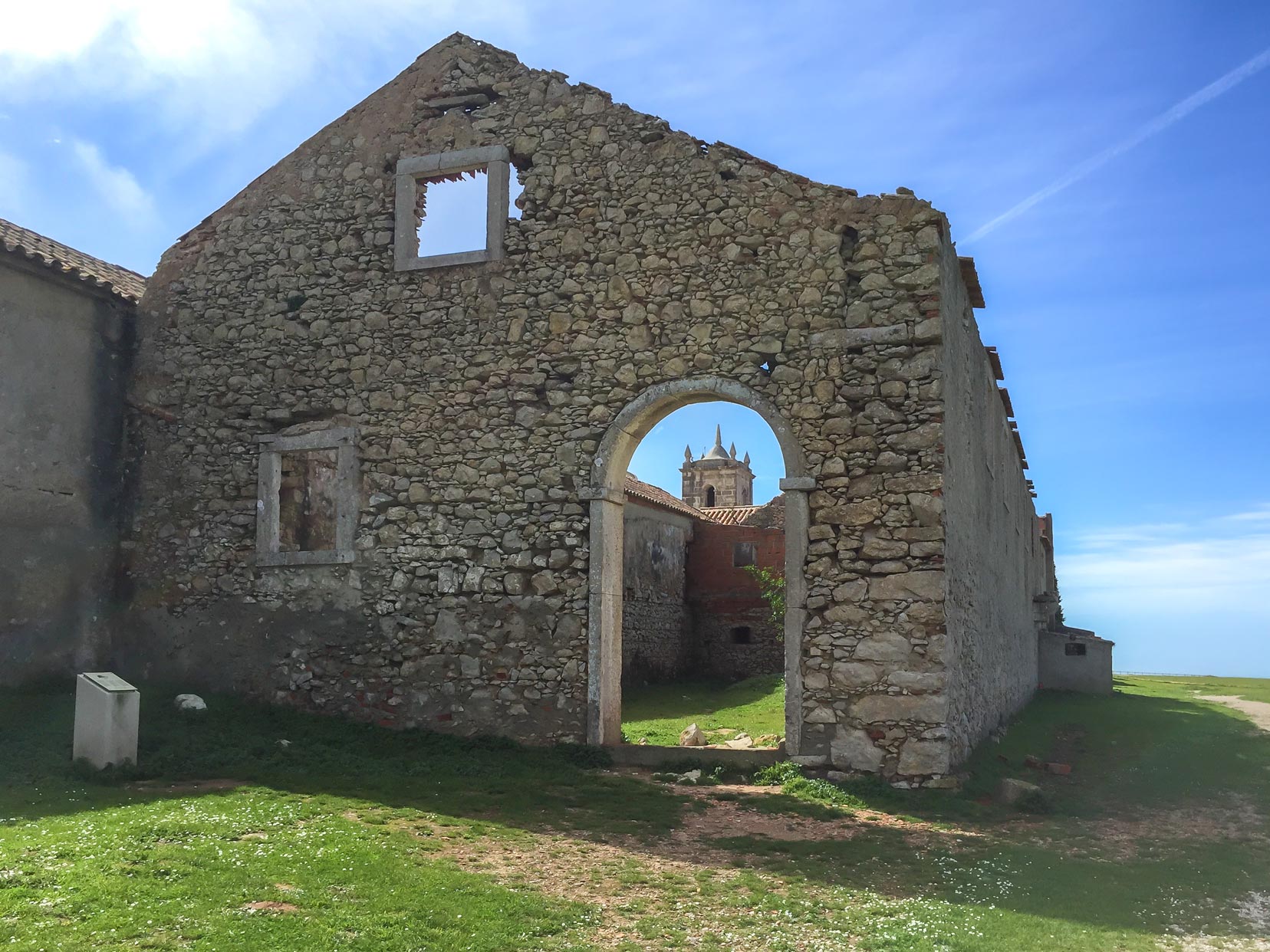
Natural Wonders:
Nature lovers will be literally blown away by the rugged cliffs and breathtaking ocean views. Did I mention the strong winds here? Ancient dinosaur tracks are visible on the cliffs.
Unique Attractions:
The Sanctuary of Nossa Senhora do Cabo Espichel, the Casa da Agua, the Ermida da Memória chapel, and the Cabo Espichel Lighthouse are historical buildings that await your visit.
Looking for inspiration and tips to capture those beautiful moments,
see our road trip photography guide.
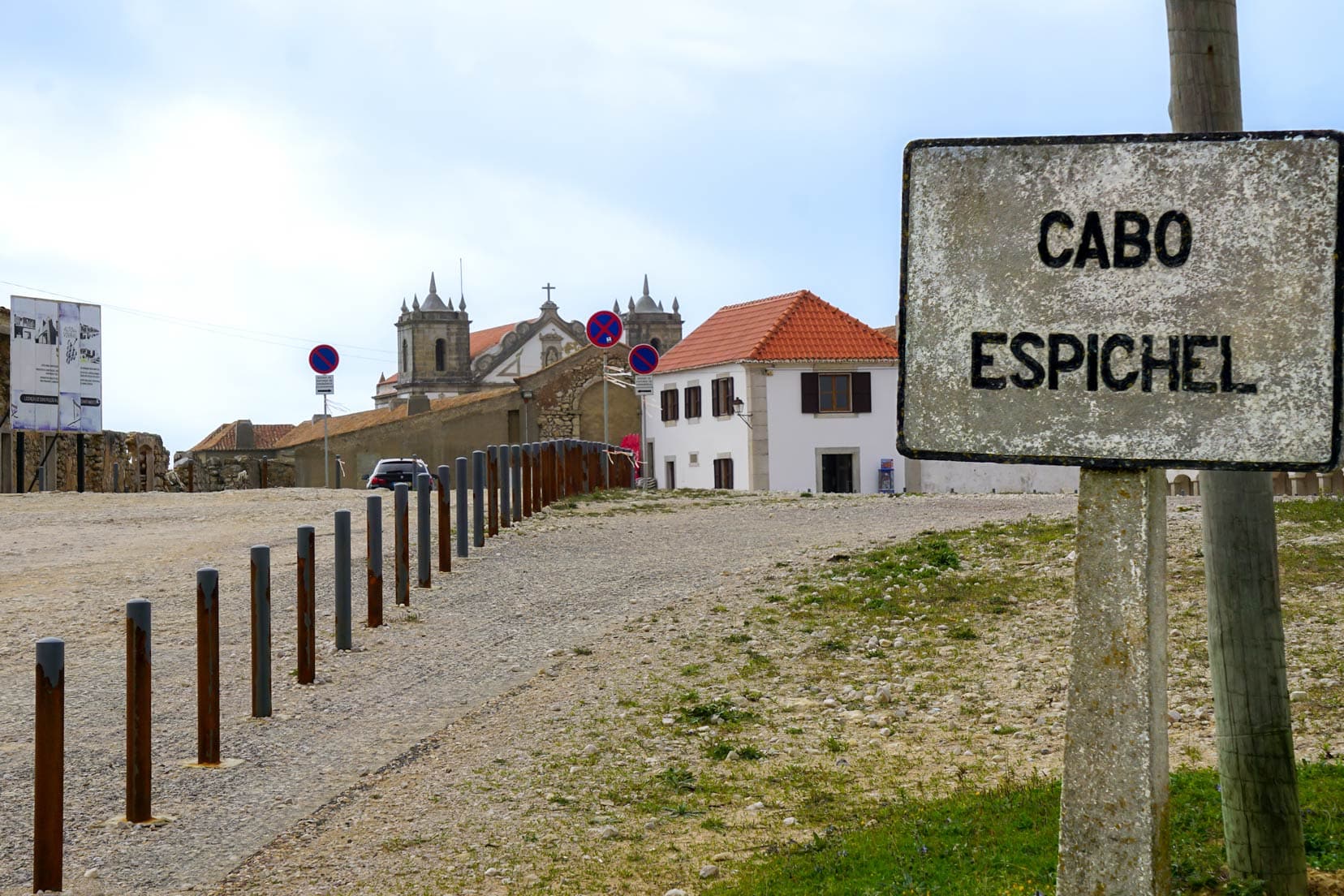
Planning a Trip to Portugal?
- 🚗 Hiring a car? We recommend getting a quote from DiscoverCars
- 🚐 Hiring a campervan? We recommend Motorhome Republic
- ⛑ Arranged your travel insurance? Compare quotes from World Nomads & Safetywing
- 🪪 Order your International Driver’s Licence online here
- 🏩 Booked your accommodation? We use Booking.com to find the best deals
- 🐾 Is someone pet-sitting for you? 🐾 We use and love TrustedHousesitters
- (Get 25% off at checkout for new memberships with our discount code: LIFEJOURNEY25)
Exploring Cabo Espichel
Cabo Espichel offers a mix of historical sites and natural beauty.
Start your visit with the sanctuary and explore the unique landmarks and stunning landscapes that define this area.
1. Santuário de Nossa Senhora do Cabo Espichel
The Santuario de Nossa Senhora do Cabo Espichel, also known as the Sanctuary of Our Lady of Cape Espichel or Nossa Senhora da Pedra Mua, was built between A.D. 1701 and 1707.
The sanctuary consists of a central church and two accommodation wings, the Casas dos Círios, which housed the many pilgrims who came to worship.
The pilgrims were drawn to Cabo Espichel because of the reported visions of the Virgin Mary riding a giant mule along the rugged cliffs. A large cross is situated on the central plane of the open square.
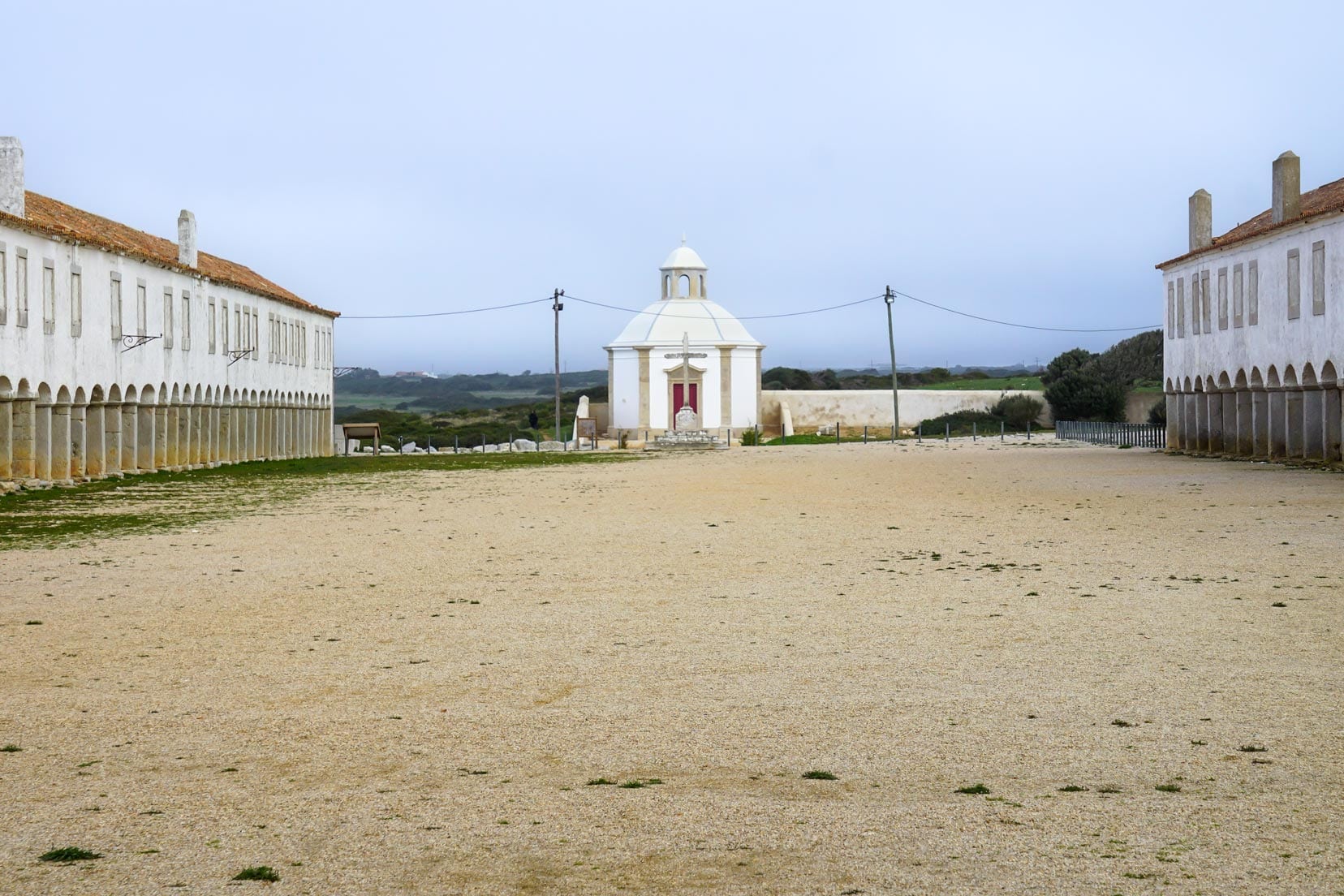
During our visit, we wandered freely about the church’s exterior, accommodation wings and remnants of the outer buildings. Unfortunately, we couldn’t gain entry as the buildings and church were locked.
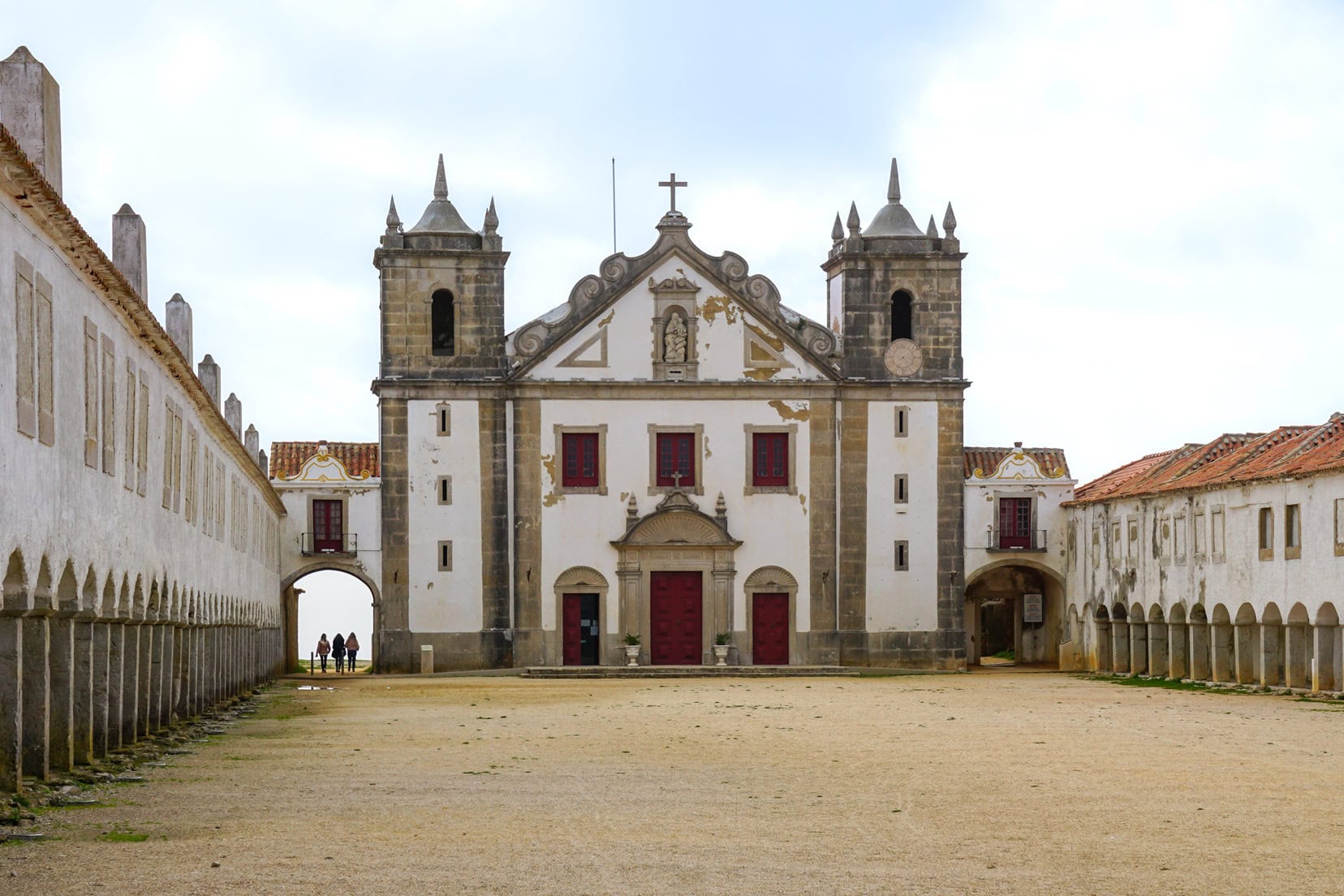
2. Casa Da Agua
Approximately 200 m in front of the church lies the Casa Da Agua, a small hexagonal building and a water house. Water was received via an aqueduct from the town of Azóia, 2 km away, from which vegetables were grown in the adjoining garden to feed the pilgrims visiting the Sanctuario.
The church, having attracted the patronage of King José I, was able to improve its facilities. Subsequently, a kitchen, oven, stables, water tank, and a small theatre were added.
The gates to the Casa Da Agua were locked, but you can view them from a distance to imagine their workings.
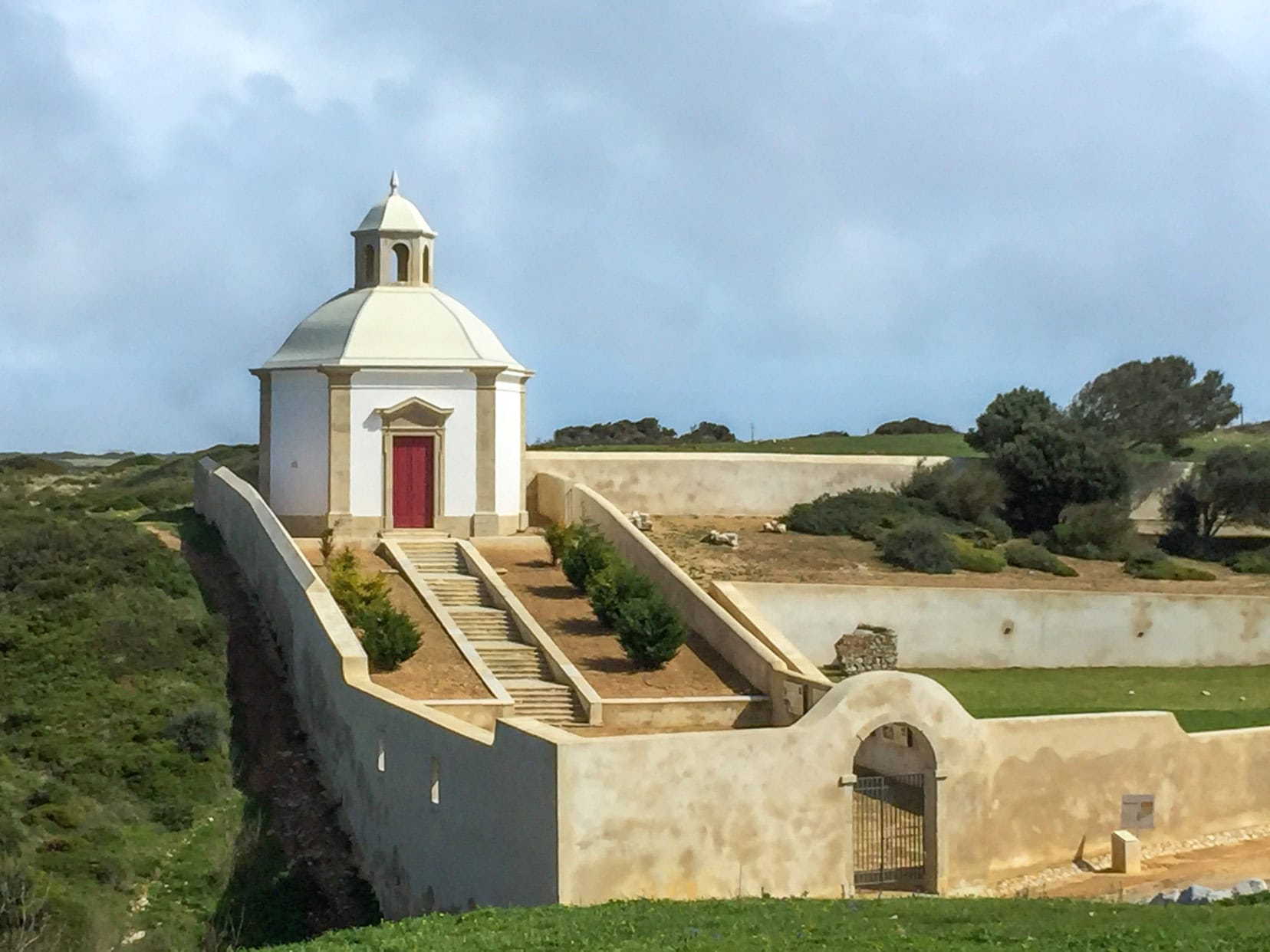
3. Ermida Da Memória Chapel
Behind the church, on the cliff’s precipice, is the ‘Ermida da Memória’ chapel. This was built in the 15th century to mark the site where the image of ‘Our Lady’ (the Virgin Mary) is believed to have ‘appeared’.
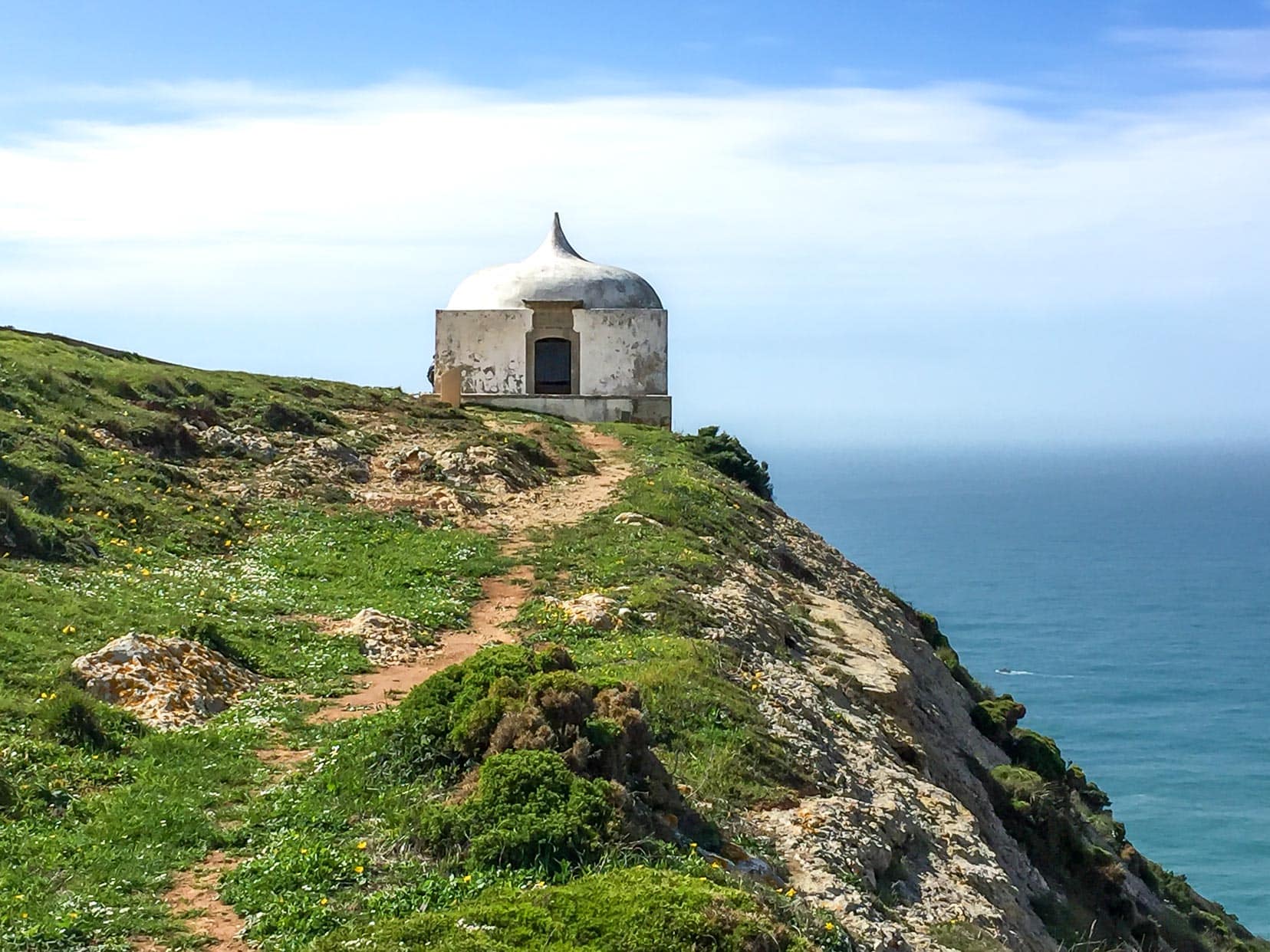
The legend tells us that an apparition of the Virgin Mary appeared, riding a giant donkey up the steep Cabo Espichel cliffs from the ocean. On reaching the top of the cliffs, the Virgin Mary apparently vanished, leaving just the footprints of the donkey.
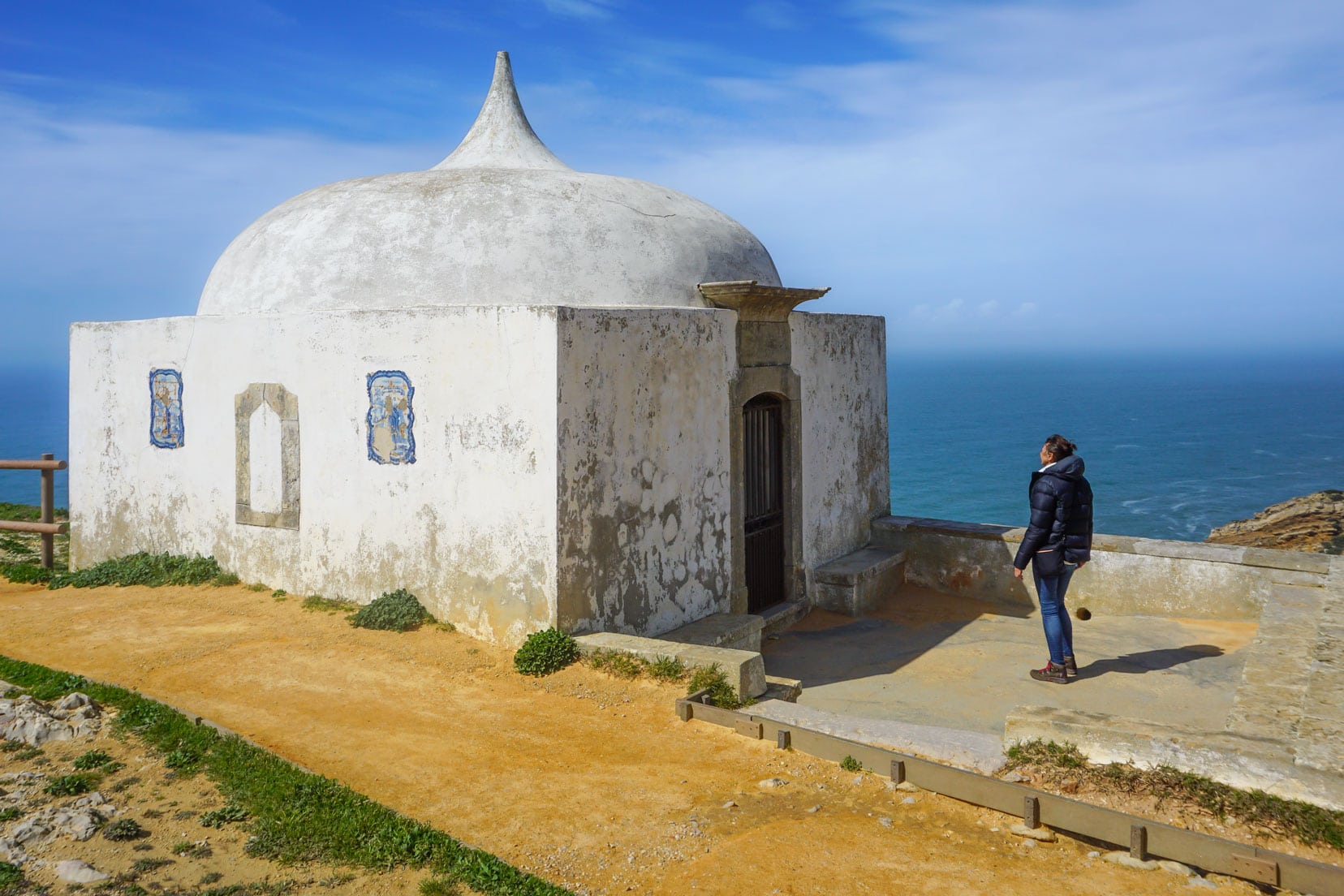
However, paleontologists have a different theory regarding the footprints on the side of the cliffs. They state they are the tracks of a dinosaur.
Access to the interior of the Ermida Da Memória Chapel was not possible. However, you can see peer through the gate at the many traditional azulejo (blue and white) tiled representations of the Virgin Mary’s vision.
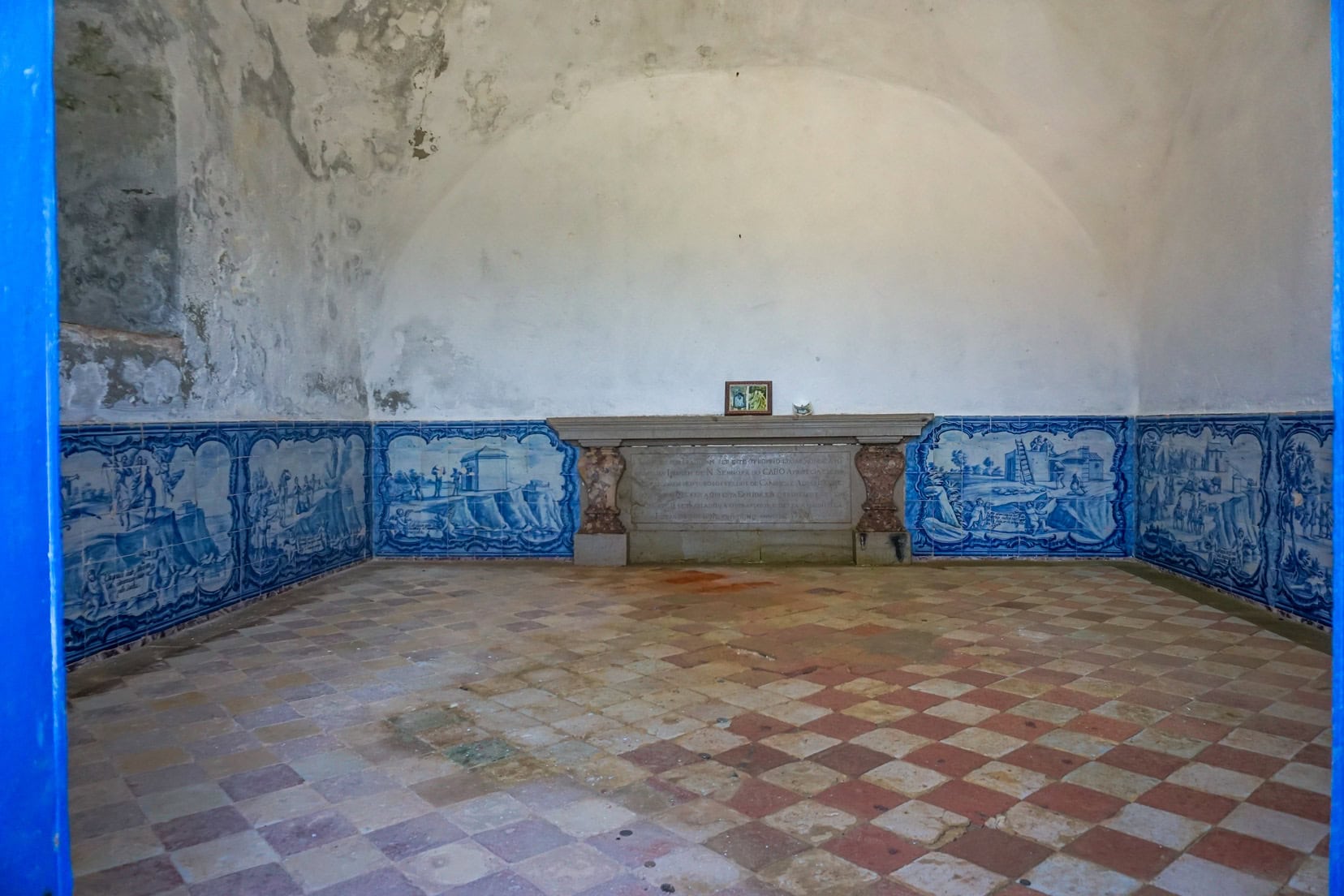
4. Farol Do Cabo Espichel – Cabo Espichel Lighthouse
Just 750m from Santuario de Nossa Senhora do Cabo Espichel is the 32m high 18th-century Farol Do Cabo Espichel or lighthouse. It stands as a lone sentinel on this wild section of coastline.
We walked partly on the road between the two and then picked our way through the countryside in search of … no, not dinosaur footprints, but geocaches. Yes, Geocaching is great fun for all the family and has led us to some amazing places you won’t find on Google.
The lighthouse began operating in 1790 and is still functional today. However, it has undergone a few technological tweaks since its construction.
It is now automated, and as part of a scheme to promote the importance of Portugal’s lighthouses, it is open to the public on Wednesday afternoons.
⭐️Visitor Tip: Time your visit on a Wednesday. Lighthouse entry is free between 14:00 pm and 17:00 pm. All talks are in Portuguese.
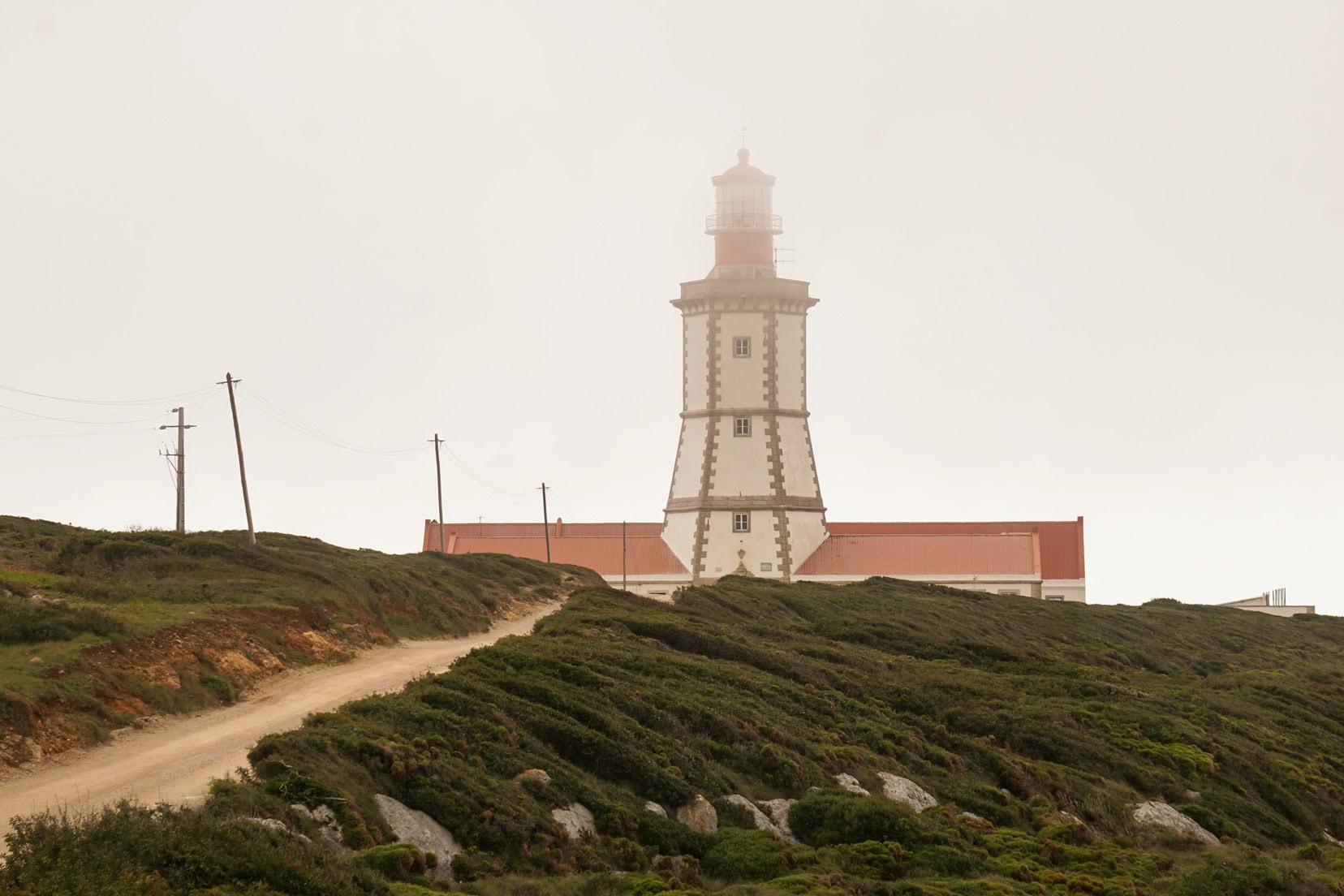
You can find a concrete building with unused machinery between the Farol do Cabo Espichel and the cliffs. At a guess, this building may have housed a generator.

There is a bit of tasteful artwork on this building, too, that I thought was actually pretty good.
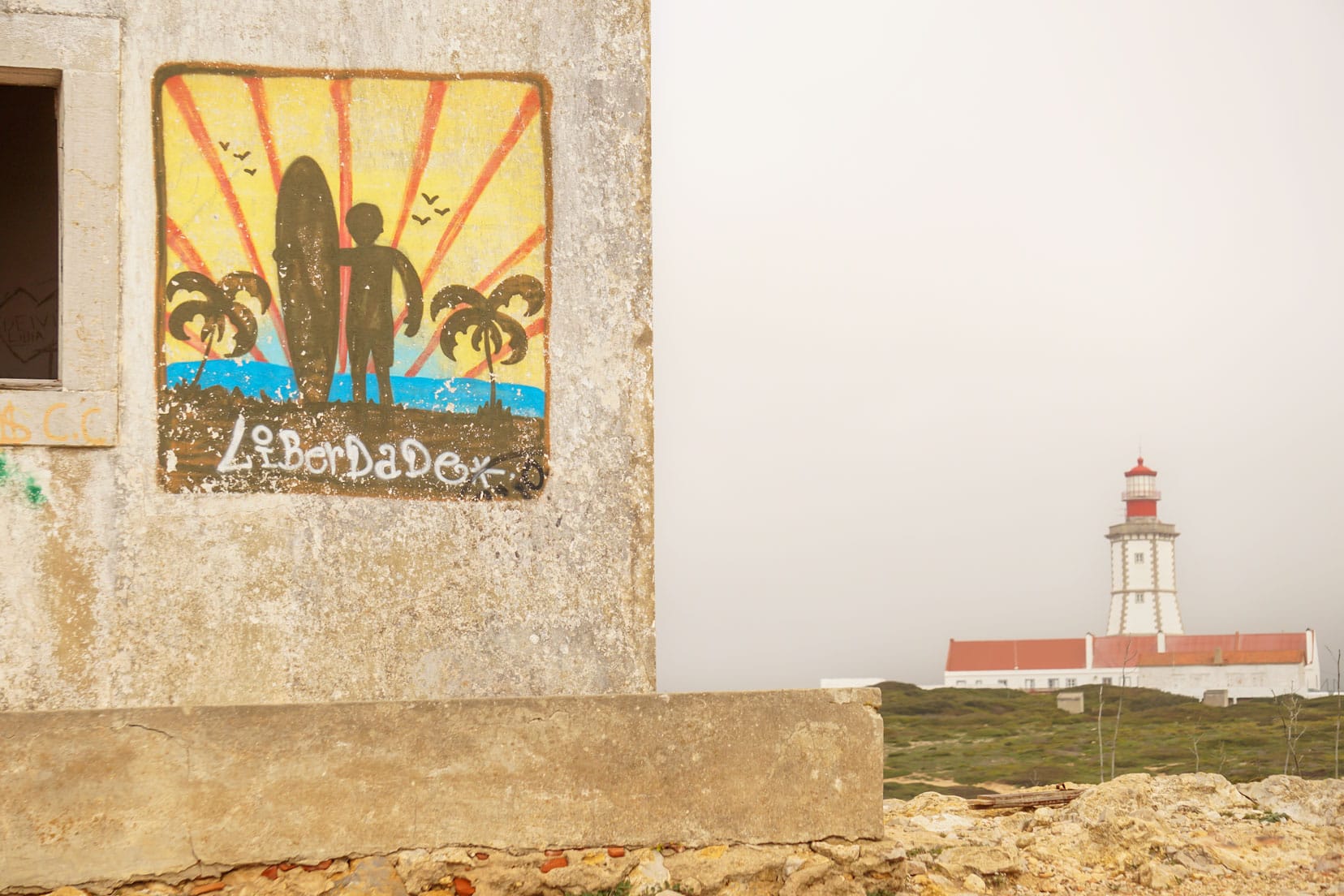
5. Dinosaur Tracks of Cabo Espichel
You can explore the religious relics and the striking Cabo Espichel lighthouse, and the area offers a fascinating glimpse into prehistoric times with nearby dinosaur tracks.
On the Cabo Espichel cliffs, you’ll find what are believed to be dinosaur footprints in the rocks. There are two notable sets: the Lagosteiros and the Pedra da Mua dinosaur tracks, both of which are north of the church.
Zoom in on the map above to locate these ancient footprints and add a unique prehistoric adventure to your visit.
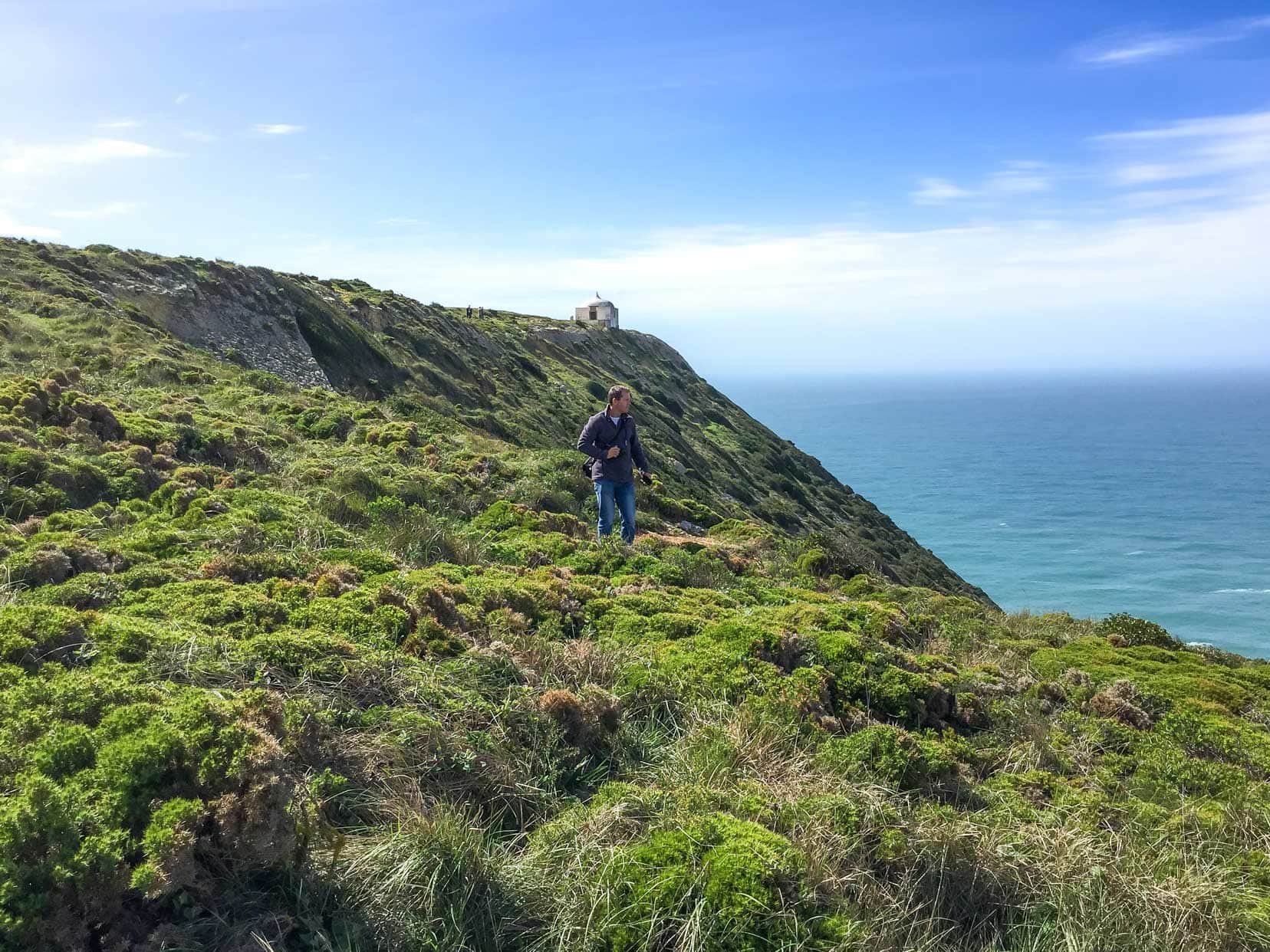
Pedra da Mua Dinoaur Tracks
The Pedra da Mua dinosaur footprints are a 20-minute walk from the church. They are closer but not easier to reach than the Lagosteiros dinosaur tracks.
Follow the signs, and you shouldn’t go wrong.
These footprints are on the cliff below the church, so you won’t be able to see them. They are imprinted on a 70m cliff face, roughly below the position of the Ermida da Memorial chapel, N38.42124, S9.21643.
There are various dinosaur footprints at Cabo de Espichel, but the ones found at Pedra da Mur are the Sauropods and Theropods. Sauropods were the big plant-eating dinosaurs with long necks, such as the Brontosaurus.
In contrast, Theropods were known for having short upper limbs and being meat-eaters, such as the Tyrannosaurus Rex.
For a better viewpoint, walk to the opposite cliffs. They’re a few 100m away, so you’ll need binoculars or a zoom lens to see any cliff markings.
Experts have dated these footprints back to the Late Jurassic period (about 160 to 145 million years ago).

Lagosteiros Dinosaur Tracks
The Pedra da Mua dinosaur tracks are quite a bit further from the church, 1.9 km away. However, if you’ve already trekked around for a better view of the Pedra da Mua footprints, the Lagosteiros dinosaur tracks are just a few hundred metres away.
Following the road from the church is the easiest way to the Lagosteiros dinosaur footprints. Many trails branch off in every direction, and it’s easy to take the wrong one, and no wonder there are many paths around the cliffs.
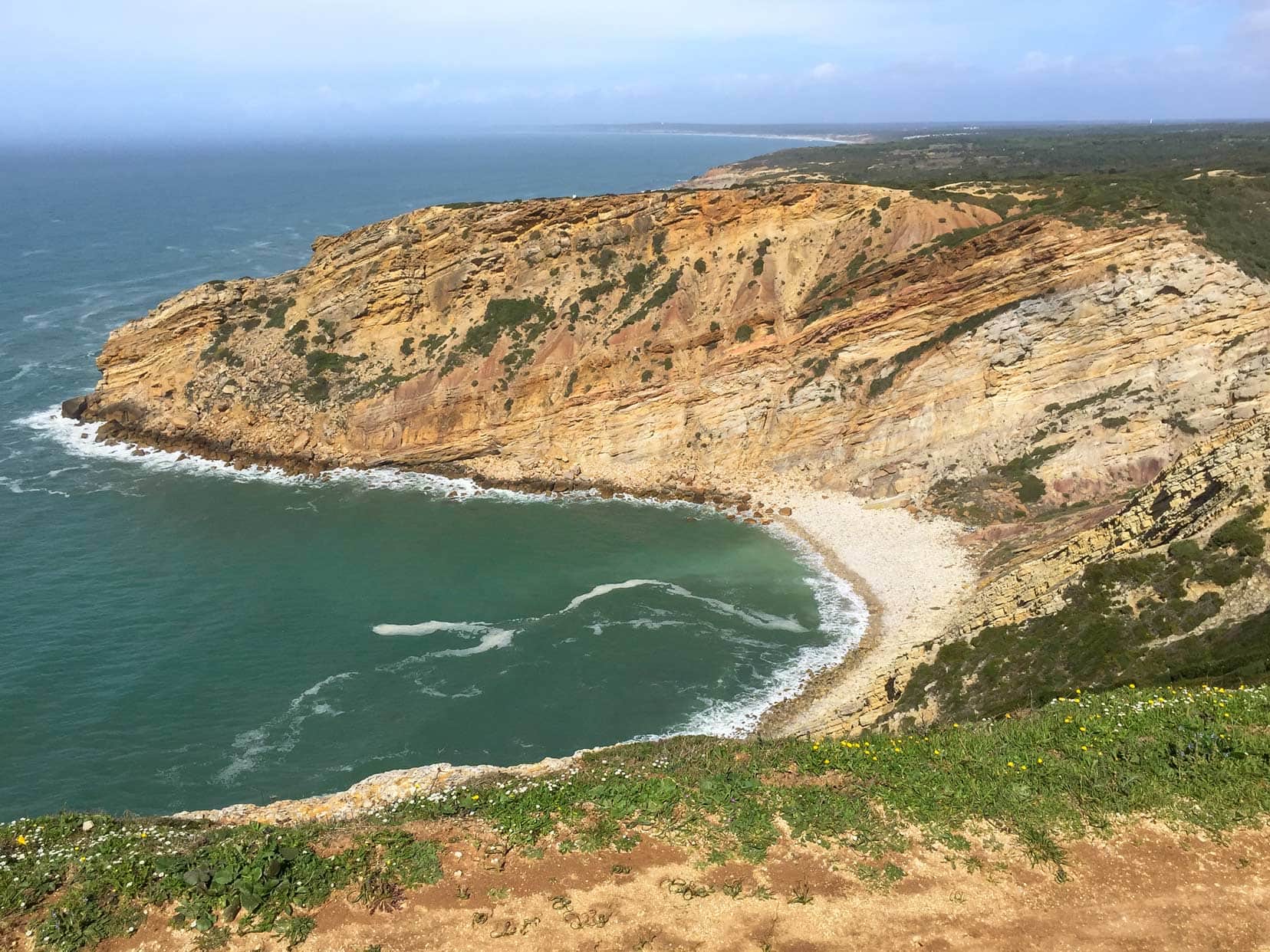
The dinosaur footprints here are of the herbivorous Ornithopod, which are animals that mostly walk on two legs but sometimes on four. These footprints date back to the Lower or Early Cretaceous period, 145 to 100 million years ago.
The Lagosteiros footprints are easier to access and can be found at positions N38.42614 and E9.21680. Look carefully, as they are not obvious to the untrained eye.
You might like to consider a 4×4 guided tour of Cabo Espichel, which takes you right to the place of the dinosaur footprints and includes a talk on the history and culture of Cabo Espichel.
6. Walk Cabo Espichel’s Wild Coastline
You might also want to consider taking one of the many well-trodden walking paths in the area. The landscapes are wonderful, whether along the cliffs or inland. Beware of the steep drops if you are close to the cliffs.
During our quest to log the many geocaches in the area, we hiked across quite a few of the paths.
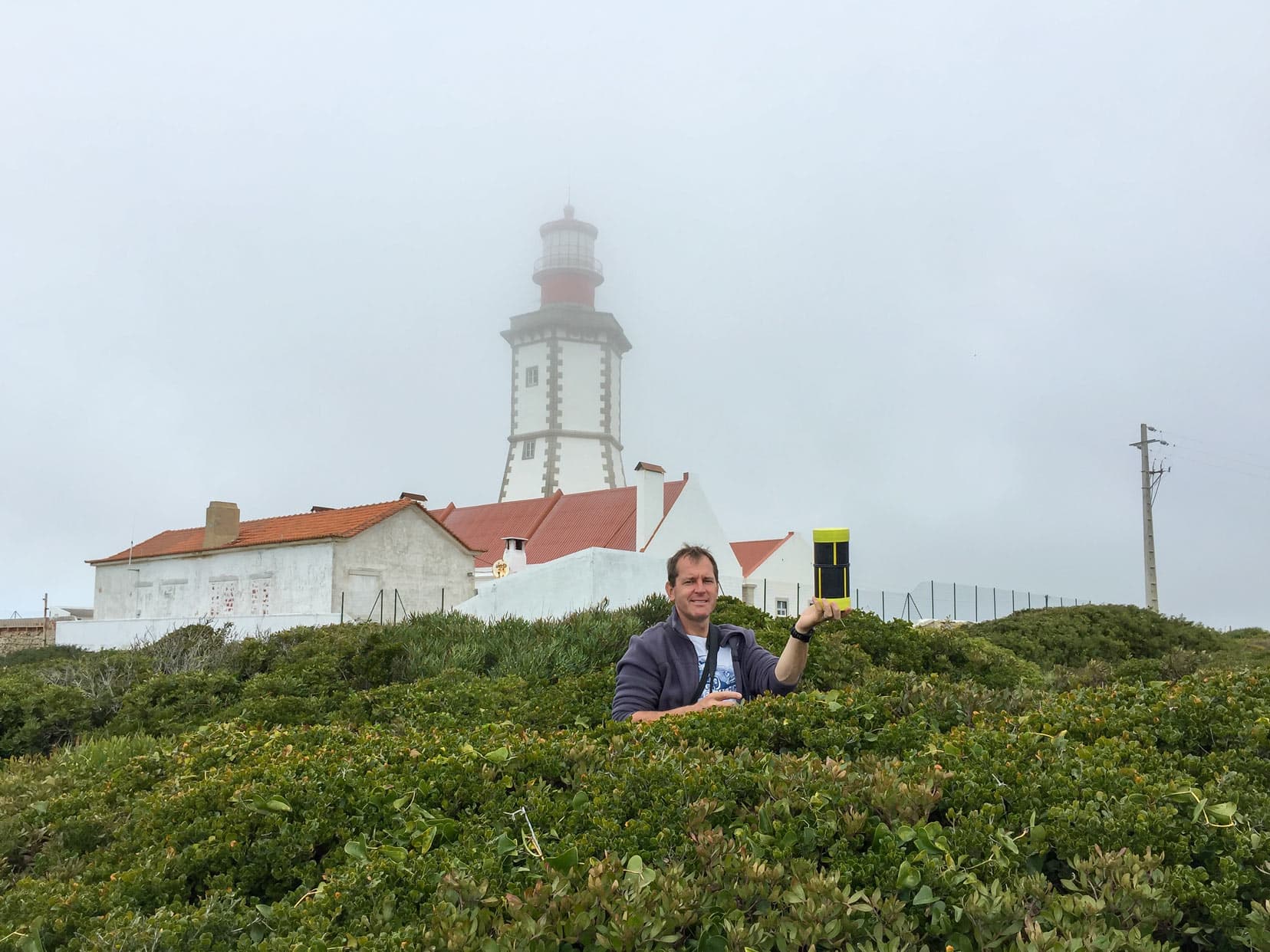
Practical Information for Visitors
🚗 Getting There
- By Car: Cabo Espichel is easily accessible from Lisbon (about a 40-minute drive) or Sesimbra (approximately 15 minutes). The route is well-signposted, and the roads are in good condition.
- Public Transport: Buses 201 and 205 run from Sesimbra to Cabo Espichel most days. Alternatively, taxis are available from Sesimbra.
🅿️ Parking
- Free Parking: Cabo Espichel offers ample free parking for cars and motorhomes. The parking area doubles as overnight parking for motorhomes, is near the church, and is central to the main attractions.
🚻 Facilities
- Restrooms: Restrooms are available at the I Love Espichel cafeteria near the church. Use will cost €1 if you are not a customer.
- Food and Drink: The cafeteria, I Love Espichel, near the church, provides food and drink. It is a cash-only establishment.
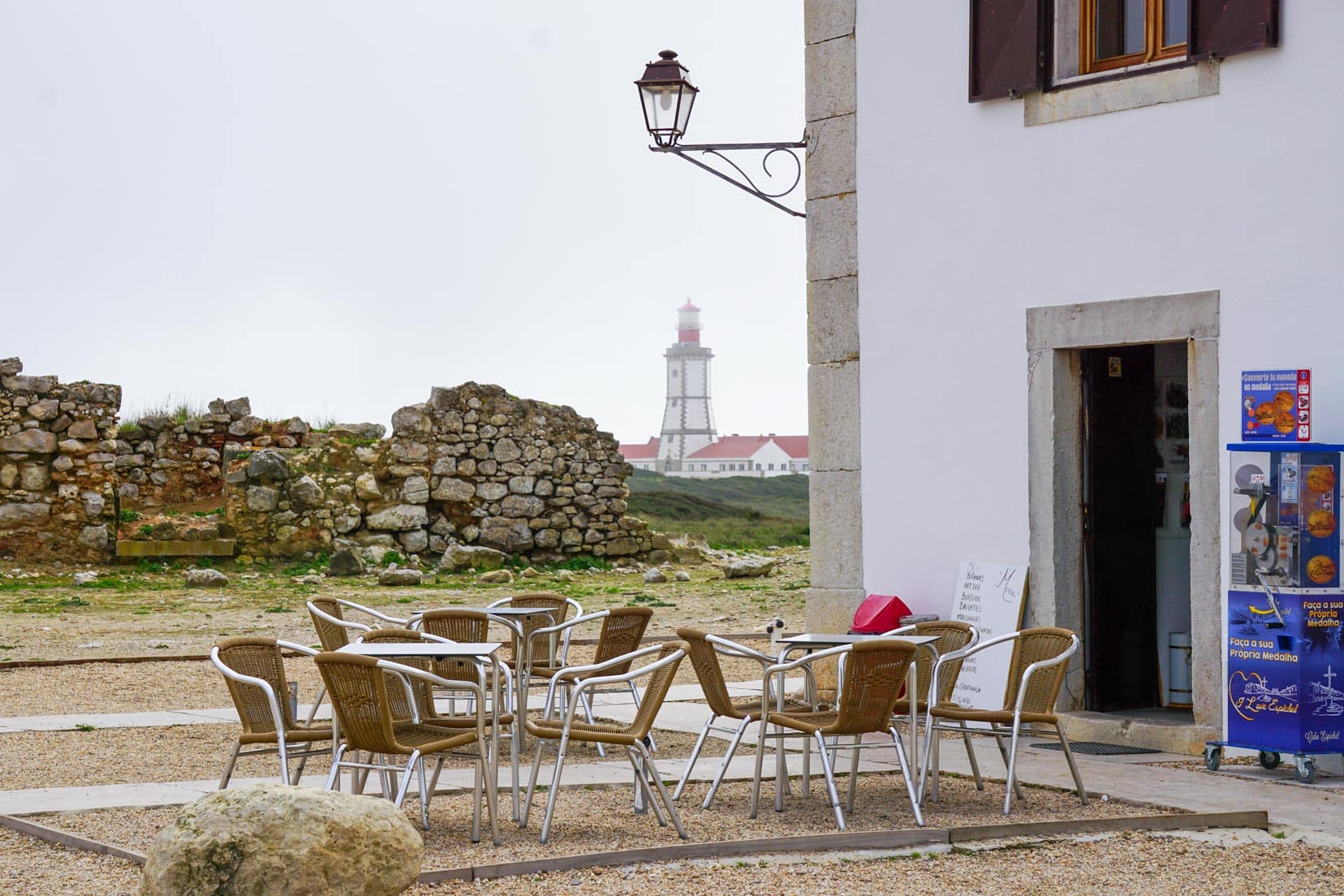
♿️ Accessibility
- Paths and Trails: The main attractions are accessible via well-maintained paths. However, some areas, like the dinosaur tracks, require walking on uneven terrain, so sturdy shoes are recommended.
- Wheelchair Access: The sanctuary and lighthouse are accessible, but the ground can be uneven. Trails to the dinosaur track sites may be quite challenging for wheelchair users.
🦺 Safety Tips
- Wind: The area is known for strong winds, so dress appropriately. Layers are advisable as it can get chilly, especially in the late afternoon. Motorhomes can expect some movement when parked due to buffeting from the winds.
- Cliff Edges: Be cautious near the cliff edges, especially on windy days. Keep a safe distance and supervise children at all times.
💨 Best Time to Visit
- Season: Late spring (April to June) and early autumn (September to October) offer the best weather, avoiding the peak summer heat and tourist crowds.
- Time of Day: Visiting early in the morning or late in the afternoon can provide stunning light for photography and a more peaceful experience.
🛐 Local Etiquette
- Respect Sacred Sites: Remember that Cabo Espichel is a pilgrimage site. Respect religious practices when visiting the sanctuary.
- Leave No Trace: Take all your rubbish with you and respect the natural environment to help preserve this beautiful area for future visitors.
Check out our comprehensive guide on how to plan a road trip to ensure you’re well-prepared before embarking on any journey.
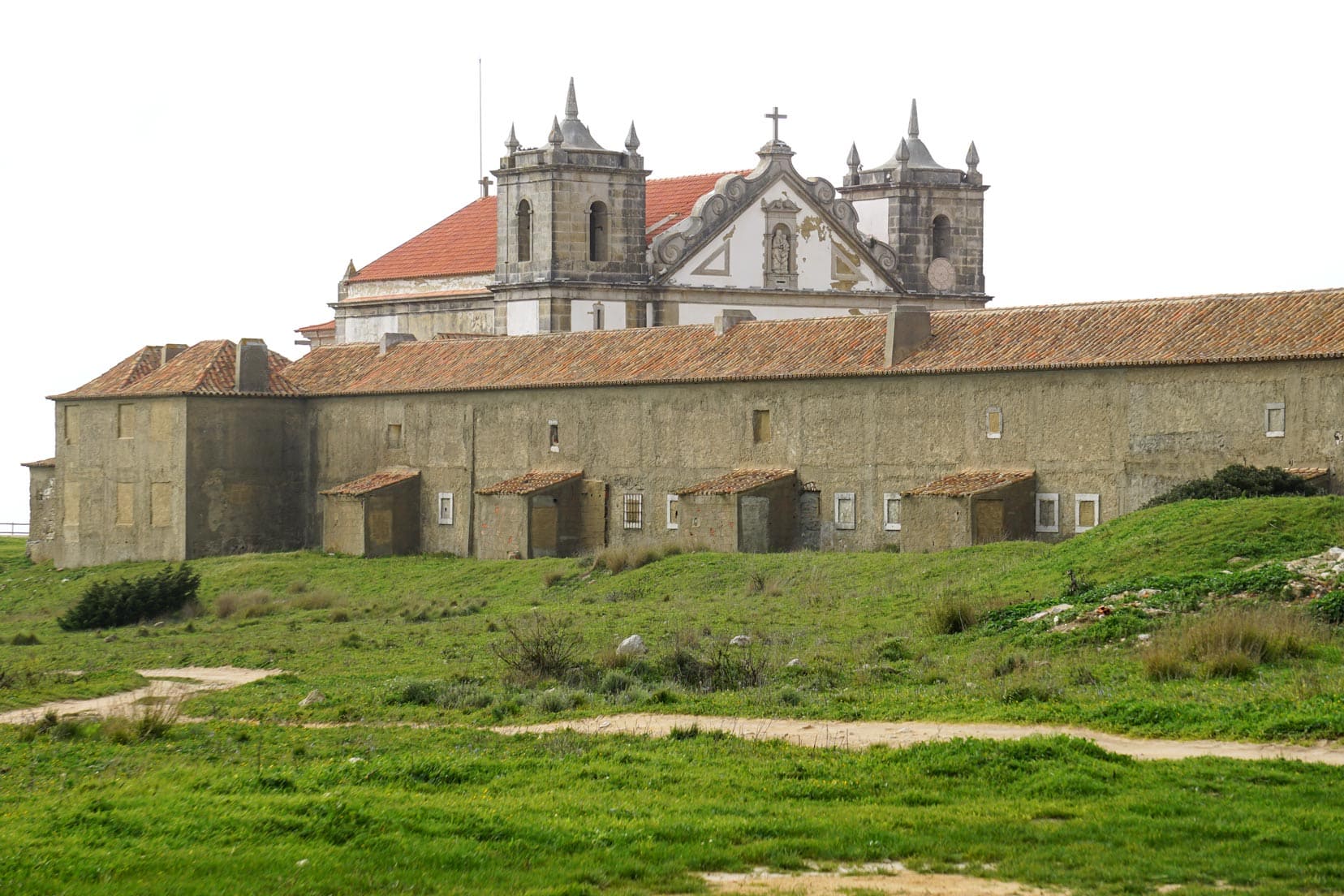
Nearby Attractions and Activities
Arrábida Natural Park
Located approximately 30 km from Cabo Espichel, Arrábida Natural Park is renowned for its stunning landscapes, including rolling hills, lush forests, and dramatic coastal cliffs.
Enjoy hiking, cycling, or birdwatching along the numerous trails. The park also offers pristine beaches, such as Praia da Figueirinha and Praia dos Coelhos, perfect for swimming and sunbathing.
Visit the Convento da Arrábida, a historic monastery nestled in the park, and explore the scenic viewpoints offering panoramic views of the Atlantic Ocean.
Or, consider embarking on a private full-day tour from Lisbon to the Arrábida wine region in Setúbal. On this tour, you’ll visit vineyards, a market, a castle, and charming villages while sampling gourmet products and wines.
⭐️ Find out more or Book this Arrábida wine region day tour here | ⭐️ 5/5 Star Reviews | ⏰ 9 hours | Badge of Excellence
Sesimbra
A charming coastal town located about 15 km from Cabo Espichel, Sesimbra is known for its beautiful beaches, fresh seafood, and historic sites.
Relax on the sandy shores of Praia da California, or Praia do Ouro or take a boat trip to explore the coastline. For some history, visit the medieval Sesimbra Castle, perched on a hilltop with stunning town and ocean views.
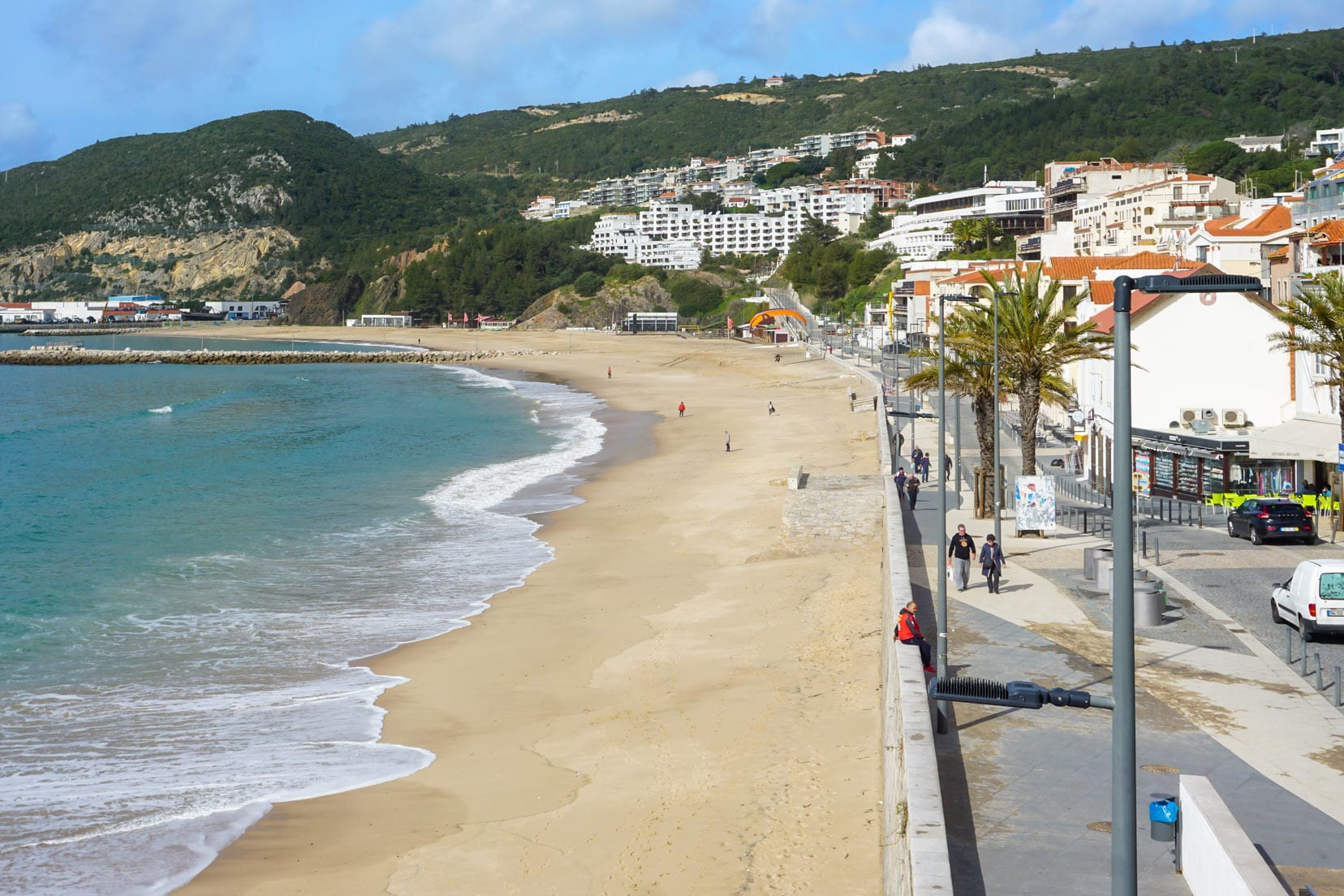
Enjoy a meal at one of the many seafood restaurants along the waterfront, offering freshly caught fish and local specialties.
If you have more time, consider a day trip to Porto. Here’s how to spend one day in Porto.
Praia do Ribeiro do Cavalo
A hidden gem located near Sesimbra, Praia do Ribeiro do Cavalo is a secluded beach known for its crystal-clear waters and dramatic rock formations.
This beach is perfect for swimming, snorkelling, and sunbathing. Access is via a hiking trail; park on the Estrada Praia da Ribeira do Cavalo.
Accommodation Options Near Cabo Espichel
Budget Option:
Mid-Range Option:
⭐️ Rating: 9.2
✔️ 5.8km from Cabo Espichel
✔️ Set in the Arrábida Nature Reserve
✔️ Superb Breakfast
✔️ Free Wifi
Luxury Option:
⭐️ Rating: 9.0
✔️ 5.5km from Cabo Espichel
✔️ Sea Views
✔️ Exceptional Breakfast
✔️ Free Wifi

Motorhome Parking – free overnight parking in the Cabo Espichel car park.
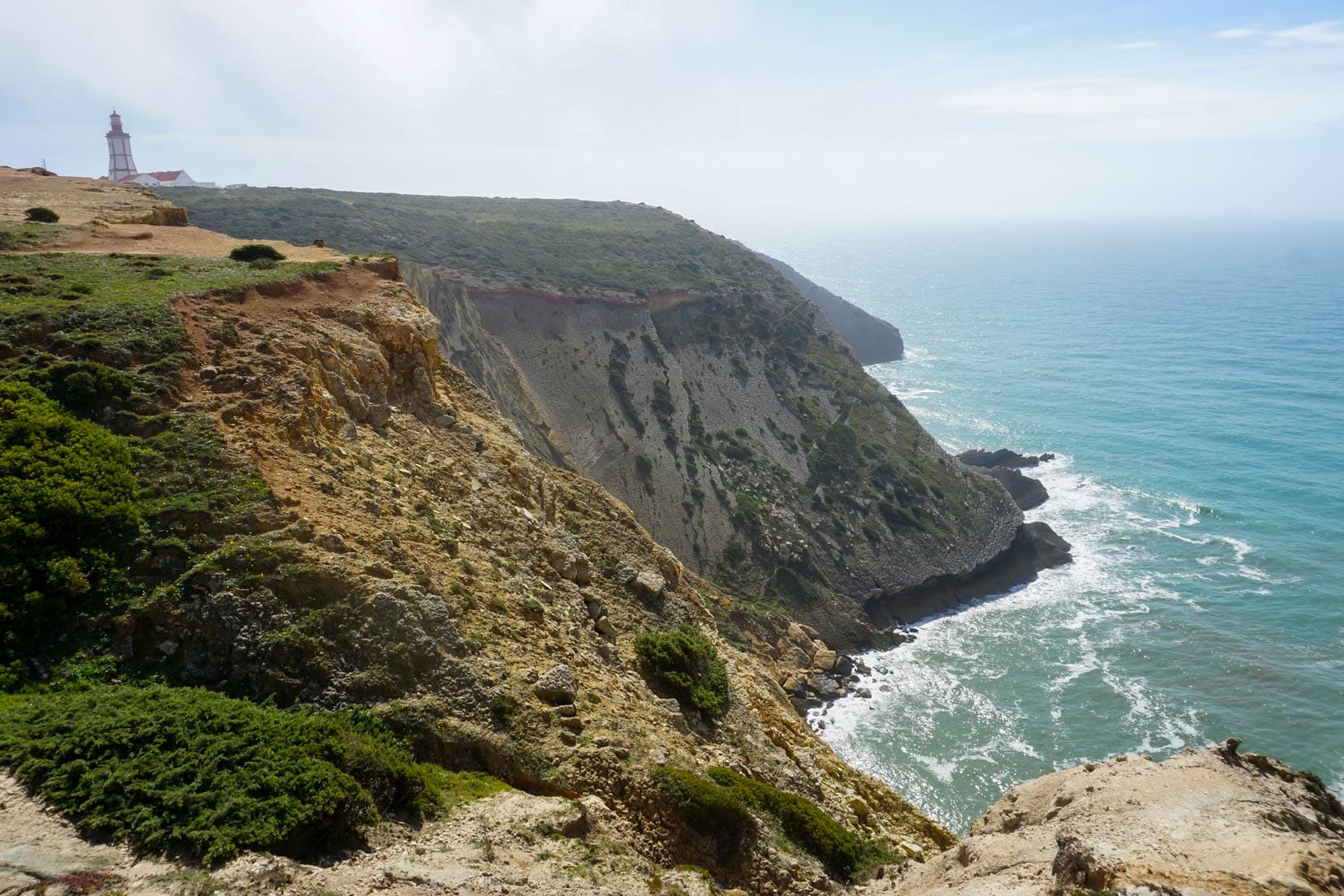
Cabo Espichel … That’s a Wrap
Cabo Espichel’s wild beauty and rich history make it a must-visit destination on the Setubal Peninsula. From the dramatic cliffs and ancient dinosaur tracks to the historic Sanctuary of Our Lady of Cape Espichel, the area offers a unique mix of natural wonders and cultural significance.
Whether you’re interested in the legends of the Virgin Mary or the prehistoric footprints, there’s something to captivate every visitor.
Are you ready to plan your trip to Cabo Espichel and immerse yourself in its stunning landscapes and unforgettable history?
Pin and Save for Later
Planning Your Travels?
These are the travel resources we recommend and use when planning our trips.
- 🚘 Car Hire: We use DiscoverCars.com
- Motorhome/Campervan Rental: We highly recommend the Motorhome Republic
- 🪪 Order your International Driver’s Licence online here
- 🛏 Book Accommodation: We use Booking.com to find accommodation that suits our budget
- 🐶 Pet Sitting/Pet Sitters: Check Out TrustedHousesitters here (Use our Discount code: LIFEJOURNEY25 for 25% off. )
- Activities and Experiences: Get Your Guide and Viator
- Travel Insurance: Safetywing or World Nomads
- 🥾 Travel Gear and Accessories: Check out our top picks here — Lifejourney4two page on Amazon
For a more thorough list, visit our Travel Resources page here.

